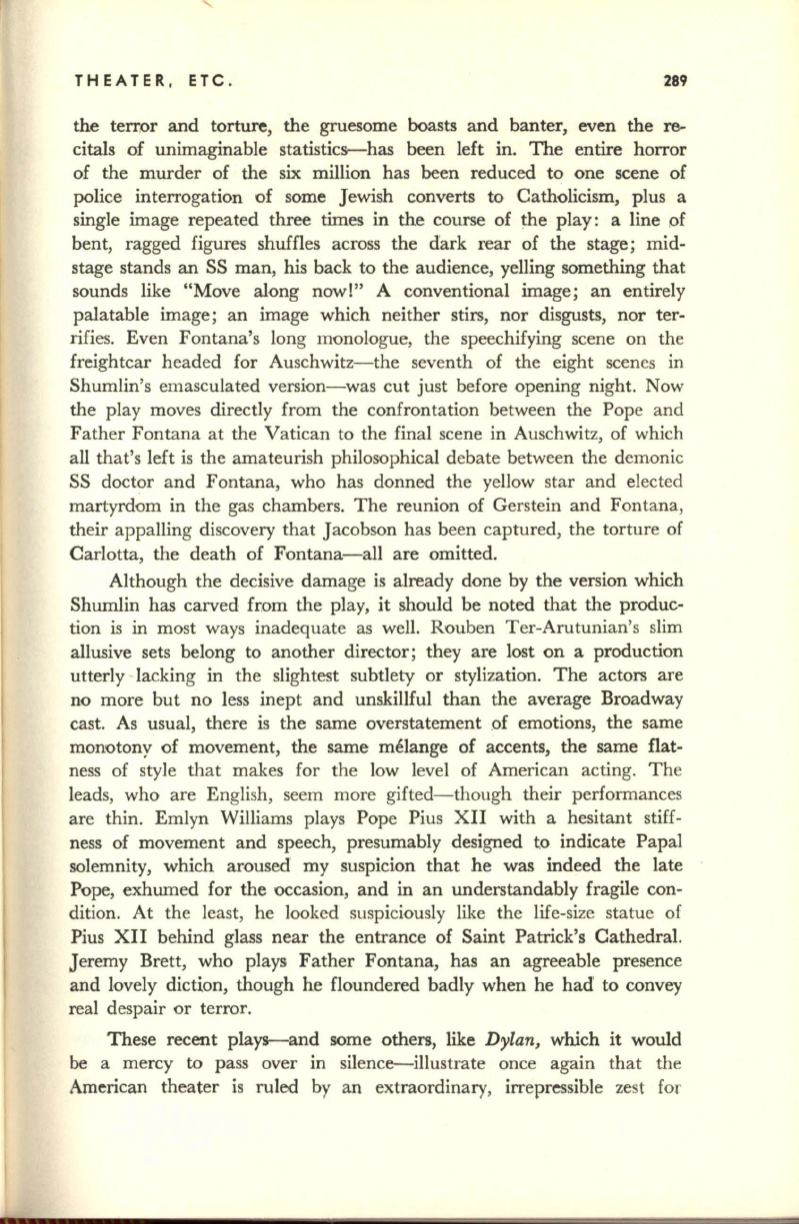
THEATER,
ETC.
289
the
te~or
and torture, the gruesome boasts and banter, even the
re–
citals of unimaginable statistics--has been left in. The entire horror
of the murder of the six million has been reduced to one scene of
police interrogation of some Jewish converts to Catholicism, plus a
single image repeated three times in the course of the play: a line of
bent, ragged figures shuffles across the dark rear of the stage; mid–
stage stands an SS man, his back to the audience, yelling something that
sounds like "Move along now!" A conventional image; an entirely
palatable image; an image which neither stirs, nor disgusts, nor ter–
rifies. Even Fontana's long monologue, the speechifying scene on the
freightcar headed for Auschwitz-the seventh of the eight scenes in
Shumlin's emasculated version-was cut just before opening night. Now
the play moves directly from the confrontation between the Pope and
Father Fontana at the Vatican to the final scene in Auschwitz, of which
all that's left is the amateurish philosophical debate between the demonic
SS doctor and Fontana, who has donned the yellow star and elected
martyrdom in the gas chambers. The reunion of Gerstein and Fontana,
their appalling discovery that Jacobson has been captured, the torture of
Carlotta, the death of Fontana-all are omitted.
Although the decisive damage is already done by the version which
Shumlin has carved fr,om the play, it should be noted that the produc–
tion is in most ways inadequate as well. Rouben Ter-Arutunian's slim
allusive sets belong to another director; they are lost on a production
utterly lacking in the slightest subtlety or stylization. The actors are
no more but no less inept and unskillful than the average Broadway
cast. As usual, there is the same overstatement .of emotions, the same
monotony of movement, the same melange of accents, the same flat–
ness of style that makes for the low level of American acting. The
leads, who are English, seem more gifted-though their performances
are thin. Emlyn Williams plays Pope Pius XII with a hesitant stiff–
ness of movement and speech, presumably designed to indicate Papal
solemnity, which aroused my suspicion that he was indeed the late
Pope, exhumed for the occasion, and in an understandably fragile con–
dition. At the least, he looked suspiciously like the life-size statue of
Pius XII behind glass near the entrance of Saint Patrick's Cathedral.
Jeremy Brett, who plays Father Fontana, has an agreeable presence
and lovely diction, though he floundered badly when he had
to
convey
real despair or terror.
These recent plays--and some others, like
Dylan,
which it would
be
a mercy
to
pass over in silence--illustrate once again that the
American theater is ruled by an extraordinary, irrepressible zest for


